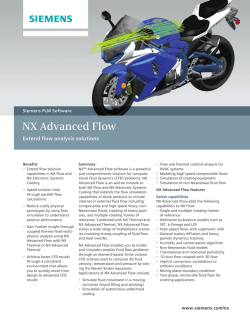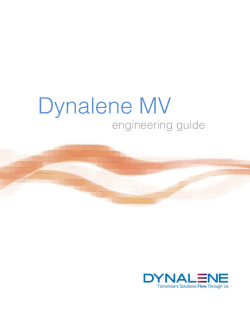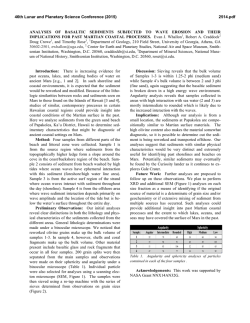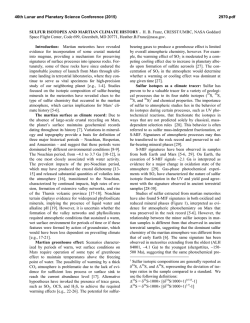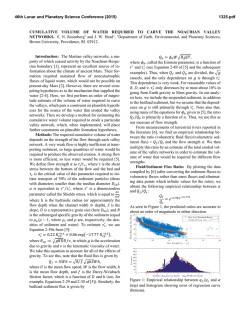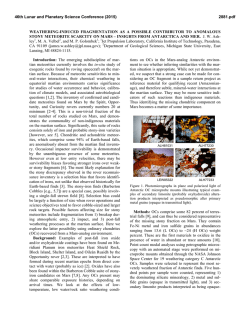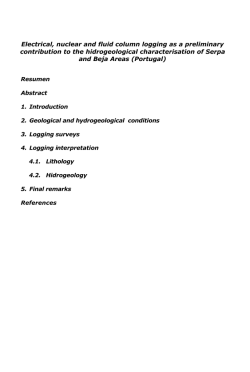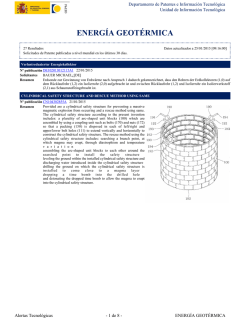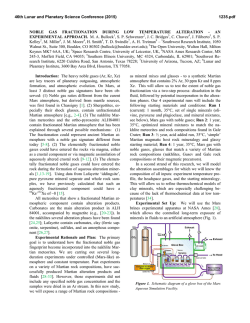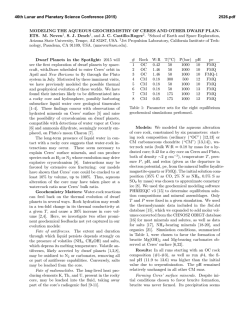
Serpentinization and carbonation of the Martian Crust with chlorine
46th Lunar and Planetary Science Conference (2015) 2128.pdf Serpentinization and carbonation of the Martian Crust with chlorine-rich fluids. B. Bultel1, F. Klein2, M. Andréani1 and C. Quantin1 1Laboratoire de Géologie de Lyon, Université Lyon 1, ENS Lyon, CNRS UMR 5271 (Laboratoire de Géologie de Lyon, Bâtiment Géode 2 Rue Raphael DUBOIS 69622 VILLEURBANNE CEDEX). [email protected] , 2 Department of Geology and Geophysics, Woods Hole Oceanographic Institution, Woods Hole, MA 02543, USA) Introduction: Carbonates are presents in Martian meteorites as minor phases and in situ analysis of the Martian dust also reveal carbonates as a minor component [1], [2]. Only orbital detections allow the analysis of the geological context of the formation of the Martian carbonates. So far, only crustal outcrops have revealed carbonates and serpentine: in an olivine rich layers link with the ejectas of Isidis basin, or in crustal outcrops such as deep canyon or central peak of large impact crater that may have exhumed crust from depth [3], [4], [5], [6] and [7]. A systematic analysis of the alteration minerals in these central peaks of impact craters on the Noachian crust has been conducted by [4]. They demonstrate that the typical mineralogical assemblage observed in central peak of impact crater between Isidis and Hellas Basins are chlorites, Fe-Mg smectites, serpentine and carbonates. The most abundant phases in term of detection are chlorite and smectite while serpentine and carbonate are rarer. A geological analysis of these detections suggests that these minerals are exhumed from depth rather than being formed at time of the impact. [8] had already pointed out that the hydration and carbonation of the martian crust lead to minor presence of serpentine and carbonates along with Mg-smectite, chlorite and talc under certain conditions. This study show that it should be a fluid dominated system, with a partial pressure of CO2 (pCO2) of 1 bar and high amount of olivine should be present in the protolith (~30%). In the present study, we used two chlorine-rich fluids to study its influence on the formation of serpentine and/or carbonates. One fluid is influenced by an ultramafic system and another by a basaltic system. The geochemical model: Our model was performed using the software code EQ3/6, version 8.0 [9] and [10] and a customized database for 0-400°C and 50MPa [11]. We add a pCO2 at 1 bar in the closed system and heat the fluid at 400°C. Then, the system is studied during a cooling from 400 to 25°C with a W/R=10. The rock is composed of 30% of olivine (Fo60), 30% of pyroxene (En90,Fs10) and 40% of plagioclase (An40) what may reflect the average basaltic composition of the Martian crust as inferred from meteorites analysis as well as in situ analysis (e.g.:[12] and [13]). Description of the fluids: We used two different fluid. One is influenced by interaction with ultramafic system (Rainbow from [14]), the other is influenced by a more basaltic system (Menez Gwen 1997 from [15]). The ultramafic fluid is high chlorininity and low silica compare to other hydrothermal fluid ([14] and references therein.). The basaltic fluid is less chlorine-rich than the ultramafic fluid (7.5x10-1 vs 4.0x10-1 molality). Both fluid are acidic (pH=2.8 vs pH=4.5). Results: The figure 1 shows the evolution of the system during the cooling from 400°C to 25°C with the fluid influenced by an ultramafic system. The %mol of the minerals in equilibrium is shown in function of the temperature. The serpentinization is predicted to occur at relatively low temperature (<160°C). The other FeMg phyllosilicates predicted are beidellite at high temperature only (>345°C), chlorite (<350°C), talc (<345°C), nontronite (<160°C) and celladonite (<80°C). Quartz is predicted to be stable from 395°C to 230°C and the iron oxyde (hematite) is predicted to be stable from 400°C to 105°C. Figure 1: Percentage of mole of minerals produced from 400°C to 25°C with the fluid influenced by an ultramafic system containing 3.10-2 mol.L-1 of CO2 at a W/R of 10. The indication -ss indicates a solid solution. The figure 2 shows the evolution of the system during the cooling from 400°C to 25°C with the fluid influenced by a basaltic system. The %mol of the minerals in equilibrium is shown in function of the temperature. The carbonation is not predicted to be efficient and accurs at T<220°C. The major phase are hematite 46th Lunar and Planetary Science Conference (2015) (iron oxyde), saponite and nontronite (Fe-Mg phyllosilicates). 2128.pdf Viviano et al., 2014 LPSC45, 1963. [8] Bultel et al., 2014, 8th Mars Conf. [9] Wolery, 1992a, Lawrence Livermore National Laboratory [10] Wolery, 1992b, Lawrence Livermore National Laboratory [11] Klein and Garrido, 2001 Lithos 126, 147–160 [12] Taylor et al., 2002 Meteor. & Planet. Sci. 37, 1107-1128 [13] McSween et al., 2003 J. Geophys. Res., vol. 108 [14] Charlou et al., 2014 Chemical Geology 191, 345– 359 [15] Charlou et al., 2000, Chemical Geology 171, 49–75 [16] Ody et al., 2012, JGR, vol. 117, E00J14 [17] Bultel et al., Icarus-in review, [18] Nils et al., 2012 Space Sci Rev [19] McCollom, 2013 Reviews in Mineralogy and Geochemistry. 75. 467–494 Aknowledgement : The research leading to these results has received funding from the European Research Council under the European Union's Seventh Framework Program (FP7/2007-2013)/ERC Grant agreement n° 280168. Figure 2: Percentage of mole of minerals produced from 400°C to 25°C with the fluid influenced by an basaltic system containing 3.10-2 mol.L-1 of CO2 at a W/R of 10. The indication –ss indicates a solid solution. Conclusion: Serpenitization is favor by a fluid influenced by an ultramafic system. Carbonation is favor by a basaltic fluid but the production of phyllosilicate is more efficient. The carbonation is limited by the combined low pH and low alkalinity of the systems (<20 mg/L CaCO3). If we compare our results with the one obtained in [8], the serpentinization is favored by the presence of Cl- while it disfavored the carbonation. Synchrones serpentinization and carbonation would necessary a fluid influenced by an intermediate system between a basalt and an ultramafic rock, similar to the high-olivine basalt detected around the serpentine detection as it is at Nili Fossae [5 and 16] or Libya Montes [3]. We will compare the mineralogical assemblages predicted here with the groups of mineral associated to carbonates and/or serpentine detected on Mars [17, 18 ]. The detailed interpretation of our sytem concerning the exchange Fe2+/Fe3+ and the composition of the solid solution will be presented. Both modelling shown here are reducing environnement which would favor CO2 reduction to organic compounds that are proposed as potential precursors for the first building blocks of life (see review in [19]). The consequences on the habitability of the environment will so be discussed. References: [1] Bridges et al., 2001 Chronology and evolution of Mars. Springer Netherlands, 365-392 [2] Tomkinson et al., 2013 Nat. Com. 4, 2662 [3] Bishop et al., 2013 J. Geophys. Res. Planets, 118, 487–513 [4] Bultel et al., 2013 EPSC [5] Ehlmann et al., 2009 J. of Geophys. Res. vol. 114 [6] Michalski and Nils, 2010 Nat. Geo. vol. 3 [7]
© Copyright 2025
